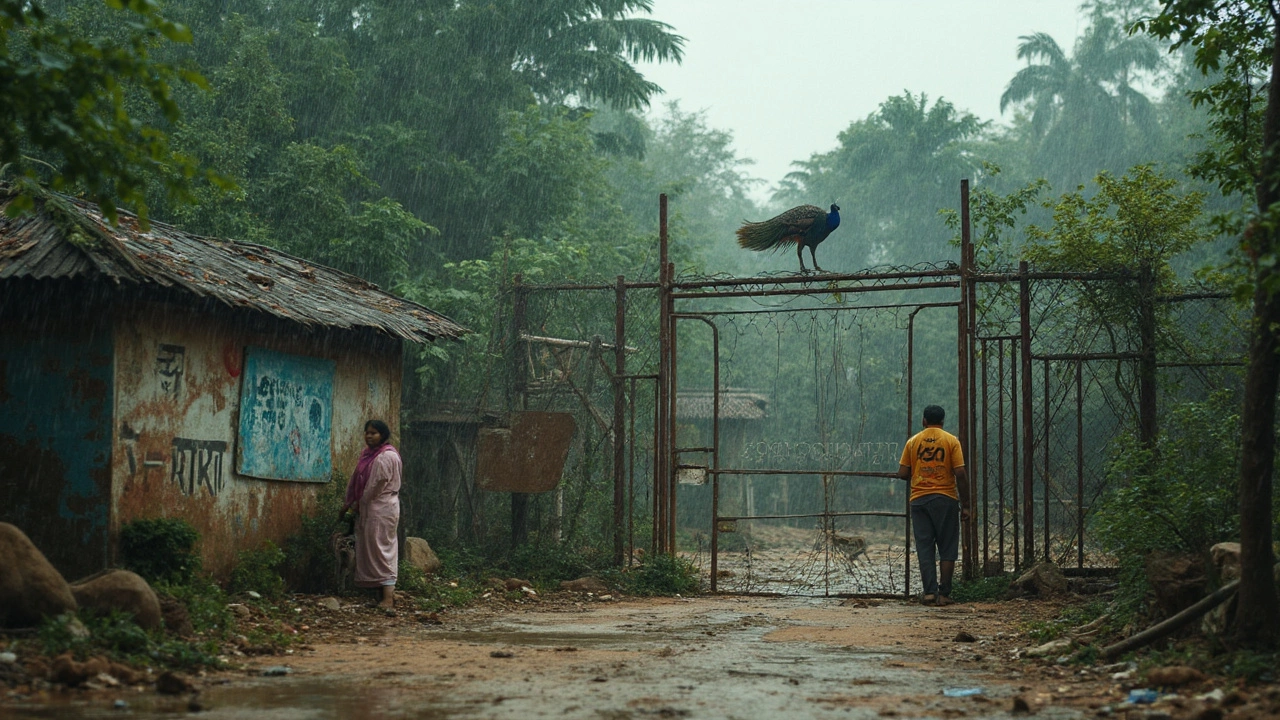Animal Sanctuaries: What Are the Cons?
 Apr, 19 2025
Apr, 19 2025
Most people think animal sanctuaries are just peaceful places where animals live happily ever after. But it’s not all sunshine and rainbows. There’s a bunch of real problems that get glossed over—like money issues, staff burnout, overcrowding, and even problems with the way animals are actually treated.
Let’s be honest—funds for sanctuaries are tight. Most run on donations, and when the cash dries up, there’s not enough to feed, house, or give medical care to all the animals. If you know anyone working at a sanctuary, they’ll tell you stories about too many mouths to feed and not enough hands to help. Animals need proper space and care, and cramming them together creates stress and health problems—not to mention fights and disease outbreaks.
- Limited Resources and Overcrowding
- Questionable Animal Welfare Practices
- Dependency on Human Intervention
- Ethical Dilemmas and Public Misconceptions
Limited Resources and Overcrowding
People love the idea of animal sanctuaries as endless safe havens, but most are strapped for cash and space. Sanctuaries don't get steady funding; they rely on donations and grants, which often aren’t enough. When money runs out, basic things like vet care, food, and shelter take a big hit. Staff has to stretch every dollar, sometimes making tough choices like skipping an animal’s wellness check or spacing out meals.
Overcrowding is another headache. One recent report from the Global Federation of Animal Sanctuaries found that over 40% of U.S. sanctuaries regularly face more animal intake requests than they can handle. When rescued animals keep coming but space stays the same, animals get packed into smaller enclosures meant for way fewer residents.
Packed living spaces are a recipe for stress. You get more fights, easier spread of diseases, and sometimes, animals don't have anywhere to hide or chill out. Imagine wild animals—used to huge territories—now stuck trying to avoid each other in small pens. It's not just uncomfortable; it's rough on their mental and physical health.
Here’s what happens when a wildlife care facility is stretched thin:
- Animals may not get proper diets or enrichment activities.
- Temporary cages or enclosures start to become permanent because upgrades cost too much.
- Vet visits get less frequent or skipped.
- Staff get overwhelmed, leading to burnout and accidents.
The kicker? Sanctuaries sometimes feel pressured to take in more animals to keep donors happy. That doesn’t help the animals already there, who need space and attention. When you visit or think about donating, ask the hard questions: Do they limit intakes? What’s their staff-to-animal ratio? How much of your dollar goes to actual animal welfare?
| Resource | Impact when Limited |
|---|---|
| Space | More stress, higher chance of disease |
| Food | Poor nutrition, stunted growth |
| Medical Care | Untreated injuries/illnesses |
| Trained Staff | Animal neglect, safety risks |
Questionable Animal Welfare Practices
Here’s something people don’t talk about much: not every animal sanctuary sticks to the highest standards when it comes to actual animal care. Just because a place calls itself a sanctuary doesn’t mean every animal is getting what it needs.
First off, not all sanctuaries have staff trained in proper wildlife care. It sounds unbelievable, but some volunteers or workers have more good intentions than experience. That means animals can end up with the wrong diets, untreated injuries, or even picked up and handled way too much. A study from the University of Oxford found that about one out of every four sanctuaries surveyed didn’t provide species-appropriate environments, which basically means some animals are stuck in the wrong kind of enclosure with nothing to do. Boredom and stress aren’t just uncomfortable, they can actually make animals sick or aggressive.
Also, not every sanctuary resists the temptation to put profit first. Some allow visitors to handle or take selfies with wild animals, just to bring in more donation dollars. Those Instagrammable moments? Often stressful and unhealthy for animals, especially if it means they’re being passed around all day. And if an animal’s main job becomes “entertaining the public,” its needs are easily ignored.
- Feeding wild or exotic animals diets based on whatever’s cheapest or available, not what they really need.
- Skipping routine medical checks because of cost or lack of expertise.
- Housing animals from very different species together—kind of like forcing dogs, cats, and birds to cohabitate—simply because there’s no space or it’s easier for staff. This causes fights and stress.
If you want to know if a sanctuary is legit, look for accreditation from groups like the Global Federation of Animal Sanctuaries. A real animal sanctuary shouldn’t advertise hands-on experiences or photo ops with rescued wildlife. Watch for red flags, like overcrowded enclosures, a focus on tourism, or a lack of clear info about care routines. Speak up or report places that treat animals like props. It actually helps protect wildlife everywhere.

Dependency on Human Intervention
Here’s the thing about animal sanctuaries: once an animal lands in one, its whole world now depends on people. A lot of rescued wildlife never learns to fend for themselves again. These animals aren’t hunting, foraging, or figuring out how to avoid danger—they’re waiting for their daily meals, vet visits, and human attention.
This isn’t just about comfort. When animals get used to humans doing everything for them, they can lose their natural instincts fast. For example, birds raised in sanctuaries may totally forget how to migrate or spot predators. Even big mammals like wolves or bears can get so familiar with people that releasing them back is almost impossible—it’s actually unsafe for both sides.
Check this out: One research project in California found that bears rescued as cubs and raised in sanctuaries had a 75% lower survival rate when released than wild-born bears. They just couldn’t figure out where to find food that wasn’t handed to them.
This deep dependency leads to another headache: what happens if the funding stops or the humans leave? Many sanctuaries have no backup plan. If a sanctuary goes out of business, the animals face neglect, starvation, or even euthanasia because they can’t survive alone anymore.
- Wildlife raised in sanctuaries are rarely suitable for release—less than 10% ever leave for the wild.
- Medical needs pile up, which means more costs and extra dependence on human care.
- Animals may develop weird behaviors, like pacing or begging, because their whole lives are shaped by routines instead of wild instincts.
So while the idea of a safe haven sounds great, this human dependence makes the situation trickier than most people realize. It’s crucial to ask how a wildlife sanctuary balances care with encouraging natural behaviors whenever possible. The healthiest sanctuaries try to mimic wild life as much as they can, even with all the risks that come with that.
Ethical Dilemmas and Public Misconceptions
The idea of animal sanctuaries sounds great on paper, but reality is a lot messier. Take the ethics issue—people assume that every sanctuary gives animals the best possible life, but that isn’t always true. There are cases where animals meant to be released back into the wild get kept in captivity because they attract visitors or bring in more donations. So, the line between rescue and just keeping animals as exhibits gets blurry fast.
One big misconception? People think sanctuaries are just like natural habitats. Most of the time, that’s far from true. No matter how nice an enclosure looks, it can’t fully mimic the wild. Lions, for example, might have space to roam, but it’s nothing compared to the miles they’d patrol outside. Stress builds up when animals don’t get enough exercise or stimulation. Over time, this leads to something called “zoochosis” – basically, animals get bored, start pacing or acting out unnatural behaviors.
Here's something that throws people off: lots of visitors think that animal interaction is helpful. Posing for photos or feeding rescued animals might feel nice, but it can hurt the animals in the long run. Human contact often makes it impossible to release some species back into the wild, because they get too comfortable around people. I once visited a so-called sanctuary that let visitors play with monkeys. The animals looked cute and happy, but staff later admitted they'd never survive outside because they relied too much on humans for food.
There’s another tricky part—sanctuaries sometimes have to make hard choices, like euthanizing animals they can’t care for anymore. That’s tough for staff and volunteers, but especially awkward for donors who give money thinking every animal lives forever. And without enough resources, animals can suffer quietly from health or mental issues that aren't obvious in a quick visit.
- Don’t trust every "sanctuary" sign—do a bit of digging online. Look for independent reviews, not just their website.
- Check if the sanctuary focuses on genuinely wild animals, or if it’s more of a zoo in disguise.
- See if they have a clear release or rehabilitation policy for injured or rescued wildlife.
- Find out how they limit unnecessary human-animal contact.
If you’re considering supporting a wildlife sanctuary, make sure your money isn’t just paying for a feel-good story. The gap between what’s marketed and what happens day-to-day can be huge.